Not quite, diesels still come about. But their complete takeover is retarded until the 1960s, and most diesels are initially for passenger trains. Then despite electrification becomes popular in the 1980s, diesels are still the norm outside certain divisions until later.@Andrew Boyd, so, US railroads ITTL would focus they investments on more modern steam power or electrification programs, and diesel engines would be delay and more secondary uses by them. On Electrification side, i can see the Little Joe model became a "common" electric engine for heavy freight operations, and many more numbers built of them.
You are using an out of date browser. It may not display this or other websites correctly.
You should upgrade or use an alternative browser.
You should upgrade or use an alternative browser.
Light at the End of the Tunnel: A TL of the American Railroad
- Thread starter Duke Andrew of Dank
- Start date
Threadmarks
View all 68 threadmarks
Reader mode
Reader mode
Recent threadmarks
ATSF's Plan B: The Rock Island Cut-up ALCO DSL-30: The Passenger Train of the Future Milwaukee Road: The Electric Avenue Passenger Rail in the Barkley Act Russel's Grand Plan Top 5 Passenger Trains in America: 1949 New York Times poll The Trailer Train Makes Its Start; 1949 The Walt Disney SurvivorsThe little joes were good freight engines so were the Virginian EL-C, and the EL-2B@Andrew Boyd, so, US railroads ITTL would focus they investments on more modern steam power or electrification programs, and diesel engines would be delay and more secondary uses by them. On Electrification side, i can see the Little Joe model became a "common" electric engine for heavy freight operations, and many more numbers built of them.
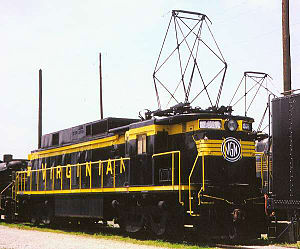
EL-C
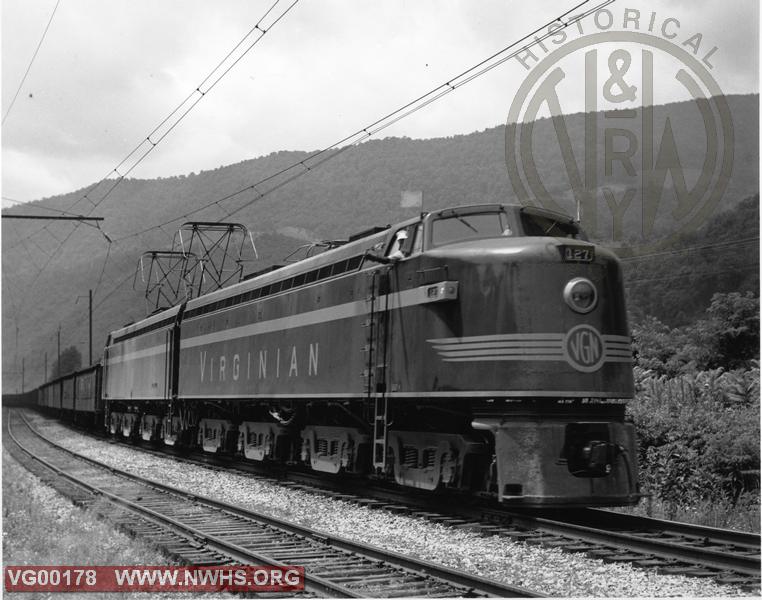
EL-2B
As I said, the real question is what to do next for 1948.
Perhaps have Chapelon and Porta create their first new steamers?
Perhaps have Chapelon and Porta create their first new steamers?
@Andrew Boyd.
I Think you could make a period that go 1948 - 1950 and have more events together.
As for oil crisis, maybe butterfly to middle/late 50s?
Chapelon and Porta first engines is a good start too. They ideas could later used on engines as PRR T1, or even they work on project too.
I Think you could make a period that go 1948 - 1950 and have more events together.
As for oil crisis, maybe butterfly to middle/late 50s?
Chapelon and Porta first engines is a good start too. They ideas could later used on engines as PRR T1, or even they work on project too.
Union Pacific Steam Power in Review (1948)
The Union Pacific Railroad has been known throughout the years as a major operator of neat and diverse steam engines. Let's take a look at some of the most unique of these engines:
Canadian Pacific-cloned Power
In the early 1930s, the Canadian Pacific and Union Pacific collaborated with each other on various locomotive designs modified to their respective preferences. During this time, the Canadian line received several carbon copies of the CSA-3 Challengers and the 9000 Series 4-12-2s for use in Canada. As well as several clones of the FEF-3 series 4-8-4s for use.

Diagram of the Canadian Pacific Q1 Class 2-8-4s, known as Laurentians. Which directly inspired the Union Pacific TEFs, and shared many components with the Hudsons. Canadian National had also built some 2-8-4s from ex-GTW Consolidation in the 1930s.
Union Pacific also received several CP designs in this case. Namely, the FSF Class 4-6-4s and the TEF Class 2-8-4s, both of which were intended for operations on the lines from Utah to the Pacific Northwest. Both engines were superb, the latter having been built directly with the same boiler as the Hudsons like what was the case on the Canadian Pacific. Both engines were especially adept to the Pacific Northwest, and the FSFs were painted in a livery very similar to that of the Challenger passenger train.
In addition, the Union Pacific considered order other famous Canadian Pacific designs. Specifically the Selkrik 2-10-4s and their cab-forward cousins, the Connaught 4-10-2s. However, these did not come to pass due to most of the freight needs being handled by stronger articulateds. Not to mention the aforementioned TEF 2-8-4s also built from Canadian Pacific designs.
Passenger Engines
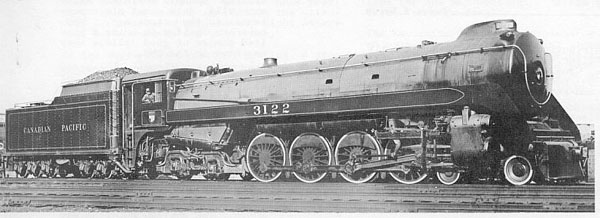
The Canadian Pacific K1b, had it been cloned for Union Pacific, would be among the few truly streamlined Union Pacific engines along the FSF engines. Indeed, many artists have drawn what-ifs of these engines as UP engines with smoke deflectors and different paint. Much like with the Selkirks above.
As was the case with most American railroads, UP operated most of the mainline passenger trains with 4-8-4s. Whereas shorter trains were usually hauled by 4-6-2s. Today, this is still the case. Albeit with the FSF 4-6-4s, built from CP Royal Hudsons, now playing major roles in some parts of the network. Mainly to the west from Utah to the Northwest or Los Angeles. In addition, the Union Pacific had considered ordering some clones of the Canadian Pacific's K1b Class 4-8-4s to serve as streamlined equivalents for use on the streamliners to either the Pacific Northwest or California.
Articulateds
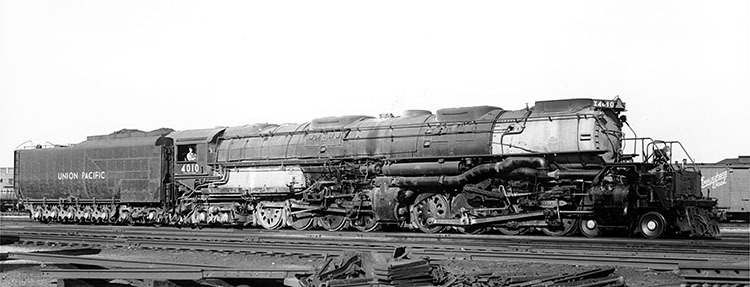
Big Boy 4010 is one of the numerous Union Pacific Articulateds preserved today. However, it will likely not run again due to being stuffed and mounted in a park in Omaha alongside a Centennial diesel.
Further east was the stomping ground of the iconic articulated types that made Union Pacific famous. Here, all the Challengers and Big Boys strutted their stuff hauling the heaviest freights west to Utah and east as far as Cheyenne or Denver. These engines would ultimately be among the last Union Pacific steamers in operation, and spent their last years on helper duty when not hauling freight.
Other Freight Engines
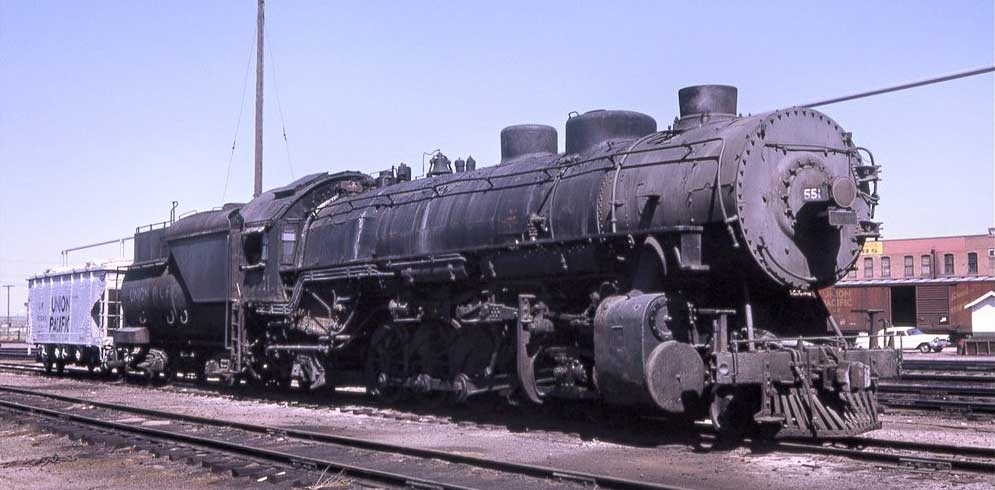
TTT-6 #5511 finished service as a helper in the Cheyenne area until eventual retirement. Today however, she works for the Steamtown Railroad Museum as an excursion engine. Which is because she is more than ideal for the slow, leisurely excursions through mountainous terrain.
In addition, smaller engines would pop up from time to time. Of particular note were the helpers in the form of 2-10-2s. These engines were not very fast, but still were perfectly capable of the needed jobs. Secondly, the 9000 Class 4-12-2s, while confined to the Plains typically, were also helpful. So much that after discovering that #9012, having been sent for display in California, could actually go well out west, the original 9000 was used in their iconic heritage program.
Canadian Pacific-cloned Power
In the early 1930s, the Canadian Pacific and Union Pacific collaborated with each other on various locomotive designs modified to their respective preferences. During this time, the Canadian line received several carbon copies of the CSA-3 Challengers and the 9000 Series 4-12-2s for use in Canada. As well as several clones of the FEF-3 series 4-8-4s for use.

Diagram of the Canadian Pacific Q1 Class 2-8-4s, known as Laurentians. Which directly inspired the Union Pacific TEFs, and shared many components with the Hudsons. Canadian National had also built some 2-8-4s from ex-GTW Consolidation in the 1930s.
Union Pacific also received several CP designs in this case. Namely, the FSF Class 4-6-4s and the TEF Class 2-8-4s, both of which were intended for operations on the lines from Utah to the Pacific Northwest. Both engines were superb, the latter having been built directly with the same boiler as the Hudsons like what was the case on the Canadian Pacific. Both engines were especially adept to the Pacific Northwest, and the FSFs were painted in a livery very similar to that of the Challenger passenger train.
In addition, the Union Pacific considered order other famous Canadian Pacific designs. Specifically the Selkrik 2-10-4s and their cab-forward cousins, the Connaught 4-10-2s. However, these did not come to pass due to most of the freight needs being handled by stronger articulateds. Not to mention the aforementioned TEF 2-8-4s also built from Canadian Pacific designs.
Passenger Engines

The Canadian Pacific K1b, had it been cloned for Union Pacific, would be among the few truly streamlined Union Pacific engines along the FSF engines. Indeed, many artists have drawn what-ifs of these engines as UP engines with smoke deflectors and different paint. Much like with the Selkirks above.
As was the case with most American railroads, UP operated most of the mainline passenger trains with 4-8-4s. Whereas shorter trains were usually hauled by 4-6-2s. Today, this is still the case. Albeit with the FSF 4-6-4s, built from CP Royal Hudsons, now playing major roles in some parts of the network. Mainly to the west from Utah to the Northwest or Los Angeles. In addition, the Union Pacific had considered ordering some clones of the Canadian Pacific's K1b Class 4-8-4s to serve as streamlined equivalents for use on the streamliners to either the Pacific Northwest or California.
Articulateds

Big Boy 4010 is one of the numerous Union Pacific Articulateds preserved today. However, it will likely not run again due to being stuffed and mounted in a park in Omaha alongside a Centennial diesel.
Further east was the stomping ground of the iconic articulated types that made Union Pacific famous. Here, all the Challengers and Big Boys strutted their stuff hauling the heaviest freights west to Utah and east as far as Cheyenne or Denver. These engines would ultimately be among the last Union Pacific steamers in operation, and spent their last years on helper duty when not hauling freight.
Other Freight Engines

TTT-6 #5511 finished service as a helper in the Cheyenne area until eventual retirement. Today however, she works for the Steamtown Railroad Museum as an excursion engine. Which is because she is more than ideal for the slow, leisurely excursions through mountainous terrain.
In addition, smaller engines would pop up from time to time. Of particular note were the helpers in the form of 2-10-2s. These engines were not very fast, but still were perfectly capable of the needed jobs. Secondly, the 9000 Class 4-12-2s, while confined to the Plains typically, were also helpful. So much that after discovering that #9012, having been sent for display in California, could actually go well out west, the original 9000 was used in their iconic heritage program.
Does anyone think I should have covered more during the war?
I do think I might have been able to cover more film. But I decided not to since the major butterflies only occur later.
I do think I might have been able to cover more film. But I decided not to since the major butterflies only occur later.
News for May - June 1948
"City Council Talks of New Intermodal Facility Out of Midway Airport; With Rail Station Involved"
- Chicago Tribune; May 4
"City Extends Trollies to Where New Suburbs Are Being Planned."
- Cincinnati Enquirer; May 10
"Lake Shore Line extended to Chicago Midway Airport."
- Chicago Tribune; May 23
"Billy Graham, Martin Luther King Jr, and Pope Pius XIII to Meet at Anti-segregation Conference in New Orleans."
- The Times-Picayune; May 30
"Santa Fe Announces Possibility of Buying Up the Frisco"
- Railway Age; May
"MGM Looks in to TV Animation; Bill Hanna and Joe Barbara Agree "If you give the cash needed to make a good cartoon"."
- Variety Magazine; May
"Southern Pacific and Canadian National propose acquiring stake in Milwaukee Road; SP also wants Rock Island"
- TRAINS Magazine; May
"Santa Fe Orders New Diesel Units for All Streamlined Trains"
- Los Angeles Times; June 2
"Canadian National and Canadian Pacific Express Desires to Expand Into America Trough Trackage Rights"
- New Yorker; June 11
"Southern Pacific to Split Stake in Central Pacific with Union Pacific; Will Start Electrification of Los Angeles - San Diego Mainline via Long Beach and Oceanside"
- San Fransisco Chronicle; June 17
"New York Central Expresses Desire to Begin Electrifying Mainline in New York"
- New York Times; June 25
- Chicago Tribune; May 4
"City Extends Trollies to Where New Suburbs Are Being Planned."
- Cincinnati Enquirer; May 10
"Lake Shore Line extended to Chicago Midway Airport."
- Chicago Tribune; May 23
"Billy Graham, Martin Luther King Jr, and Pope Pius XIII to Meet at Anti-segregation Conference in New Orleans."
- The Times-Picayune; May 30
"Santa Fe Announces Possibility of Buying Up the Frisco"
- Railway Age; May
"MGM Looks in to TV Animation; Bill Hanna and Joe Barbara Agree "If you give the cash needed to make a good cartoon"."
- Variety Magazine; May
"Southern Pacific and Canadian National propose acquiring stake in Milwaukee Road; SP also wants Rock Island"
- TRAINS Magazine; May
"Santa Fe Orders New Diesel Units for All Streamlined Trains"
- Los Angeles Times; June 2
"Canadian National and Canadian Pacific Express Desires to Expand Into America Trough Trackage Rights"
- New Yorker; June 11
"Southern Pacific to Split Stake in Central Pacific with Union Pacific; Will Start Electrification of Los Angeles - San Diego Mainline via Long Beach and Oceanside"
- San Fransisco Chronicle; June 17
"New York Central Expresses Desire to Begin Electrifying Mainline in New York"
- New York Times; June 25
Last edited:
UPDATE: 6/13/19
I have no intention of giving up on TTL.
But I have had trouble trying to figure what things to do. Like how to detail movies (though the butterflies there mostly hit later).
But I have had trouble trying to figure what things to do. Like how to detail movies (though the butterflies there mostly hit later).
Chicago: Start of the Passenger Intermodal
July 5, 1948
Chicago, IL
Mayor Martin H. Kennelly was in a conference room. With him were numerous representatives of Chicago's railroads. The Santa Fe, Rock Island, New York Central, Pennsylvania, Milwaukee Road, Baltimore & Ohio, you name it. All were eyeing him intently, as were many airline executives and real estate developers. There was a long, awkward silence, until Fred Gurley, president of the Santa Fe, spoke up.
"So, Mr. Kennelly" he asked. "What's your proposition?"
"Well." explained Kennelly. "The City Council and I have been pondering the possibility of using Midway Airport as a new intermodal terminal."
"A what?" interrupted J. D. Farrington, president of the Rock Island.
"You see." explained Kennelly. "My idea was to build a new rail station as part of the facility. That way, passengers from a train can just get over from one part of the facility to the other so they can fly to say... Melbourne in Australia."
"I'm not sure the term intermodal is appropriate then." Farrington interjected.
"Got a better term?" asked Kennelly. When Farrington didn't reply, he continued.
"The Lake Shore Commuter trains and elevated lines will also be able to stop at this place. With each one having two tracks to use." went on Kennelly. "These tracks will be the same one as the Belt Railway of Chicago's just line east of the airport. The shed under which trains stop will also be there."
"What about the stations we have already?" asked Gurley.
"That's not something we have completed thought too much of yet." replied Farrington. "But we were thinking we will use them as further commuter terminals."
"Well, why not just use one station. Maybe Union Station?"
After that question, Farrington returned to the drawing board.
Chicago, IL
Mayor Martin H. Kennelly was in a conference room. With him were numerous representatives of Chicago's railroads. The Santa Fe, Rock Island, New York Central, Pennsylvania, Milwaukee Road, Baltimore & Ohio, you name it. All were eyeing him intently, as were many airline executives and real estate developers. There was a long, awkward silence, until Fred Gurley, president of the Santa Fe, spoke up.
"So, Mr. Kennelly" he asked. "What's your proposition?"
"Well." explained Kennelly. "The City Council and I have been pondering the possibility of using Midway Airport as a new intermodal terminal."
"A what?" interrupted J. D. Farrington, president of the Rock Island.
"You see." explained Kennelly. "My idea was to build a new rail station as part of the facility. That way, passengers from a train can just get over from one part of the facility to the other so they can fly to say... Melbourne in Australia."
"I'm not sure the term intermodal is appropriate then." Farrington interjected.
"Got a better term?" asked Kennelly. When Farrington didn't reply, he continued.
"The Lake Shore Commuter trains and elevated lines will also be able to stop at this place. With each one having two tracks to use." went on Kennelly. "These tracks will be the same one as the Belt Railway of Chicago's just line east of the airport. The shed under which trains stop will also be there."
"What about the stations we have already?" asked Gurley.
"That's not something we have completed thought too much of yet." replied Farrington. "But we were thinking we will use them as further commuter terminals."
"Well, why not just use one station. Maybe Union Station?"
After that question, Farrington returned to the drawing board.
Consolidating intercity and regional rail to one station (with through-tracks), a station with excellent transfers to the local mass transit rail network?
I like it. Maybe add an airport express from that station? Inter city bus terminal across the street?
Fund it partially by building skyscrapers taller than anything before in Chicago on the surrounding blocks?
I like it. Maybe add an airport express from that station? Inter city bus terminal across the street?
Fund it partially by building skyscrapers taller than anything before in Chicago on the surrounding blocks?
Perhaps. We're not quite to when it will be built yet though.Consolidating intercity and regional rail to one station (with through-tracks), a station with excellent transfers to the local mass transit rail network?
I like it. Maybe add an airport express from that station? Inter city bus terminal across the street?
Fund it partially by building skyscrapers taller than anything before in Chicago on the surrounding blocks?
It'd be a big project that'd take several powerful and independent minded corporations and politicians having the same goal. Can be done through open and honest good intentions for the betterment of the City. Or by corrupt backroom deals aimed at securing a legacy for one or two major players. I wonder which way it'd happen in Chicago...Perhaps. We're not quite to when it will be built yet though.
Either way, I'm probably focusing on other things first. Wether it be how I save certain railroads (the PRR, Rock Island, and Milwaukee), or the Rio Grande narrow gauge's rebirth ITTL.It'd be a big project that'd take several powerful and independent minded corporations and politicians having the same goal. Can be done through open and honest good intentions for the betterment of the City. Or by corrupt backroom deals aimed at securing a legacy for one or two major players. I wonder which way it'd happen in Chicago...
Likewise, I still am thinking of what I could do to either make Amtrak better or preserve privately-operated passenger rail.
Walt's Choice: June 6, 1948
"Are you sure you don't want to direct Cinderella at all?" asked Ward Kimball.
"No." said Walt Disney firmly. "You remember Fantasia, don't you?"
"That was only a bomb because of the war." said Kimball smoothly. "Walt, you still have that spark. Trust me on this one."
Walt considered Ward's comment throughout the day. The next morning, Walt met his animators to make an important announcement.
"I'll direct it." he said concisely.
"No." said Walt Disney firmly. "You remember Fantasia, don't you?"
"That was only a bomb because of the war." said Kimball smoothly. "Walt, you still have that spark. Trust me on this one."
Walt considered Ward's comment throughout the day. The next morning, Walt met his animators to make an important announcement.
"I'll direct it." he said concisely.
Does anyone think I should reboot this TL.
I ask because there are several things I wish I went through with adding. Namely more details on TTL's locomotives, earlier mergers, etc.
I ask because there are several things I wish I went through with adding. Namely more details on TTL's locomotives, earlier mergers, etc.
Does anyone think I should reboot this TL.
I ask because there are several things I wish I went through with adding. Namely more details on TTL's locomotives, earlier mergers, etc.
I really wouldn't unless everything is going to be 110% organized and concise
News for July - August 1948
"The ATSF's desire admittedly has genuine merit. Not only would the Frisco let Santa Fe close up major holes in its line through Oklahoma and Texas. But it would also let them transfer traffic to southern roads, namely the Southern and Seaboard Air Line, in an area not as congested as New Orleans. As for passenger traffic, Santa Fe has stated if the project goes through, Frisco lines in Kansas will be used to reroute passenger trains running to California via Wichita."
- Trains Magazine; July
"Walt Disney shows of some art from his return to directing in Cinderella."
- Esquire; July
"Southern Pacific Begins Merger Talks with Rock Island as Countermove to Santa Fe - Frisco merger."
- Los Angeles Times; July 6
"Merger Proposed of Famous Suidios/DC Comics. DC CEO says if it happens 'Superman & Batman cartoons may be on TV'"
- New York Times; July 12
"City Council Proposes Streetcars to be extended across state border to Kentucky"
- Cincinnati Enquirer; July 18
"City Council Considers Trolly System"
- Atlanta Journal-Constitution; July 23
"When we eventually replace steam, I would personally like to see there be electrification of the line from Cincinnati to Chattanooga."
- Earnest E. Norris, CEO of the Southern, in an interview for Chattanooga Times Free Press; July 30
"Pacific Electric Upgrades on Southern Division Completed"
- Los Angeles Times; August 7
"Judy Garland Expresses Support for MLK, Graham, and Pope intheir desegregation campaign"
- The Los Angeles Time; August 19
"Rio Grande Railroad Proposes That Passenger Service be the norm for Narrow Gauge Operations; Has Insulted the Car in New Ads"
- The Denver Post; August 22
- Trains Magazine; July
"Walt Disney shows of some art from his return to directing in Cinderella."
- Esquire; July
"Southern Pacific Begins Merger Talks with Rock Island as Countermove to Santa Fe - Frisco merger."
- Los Angeles Times; July 6
"Merger Proposed of Famous Suidios/DC Comics. DC CEO says if it happens 'Superman & Batman cartoons may be on TV'"
- New York Times; July 12
"City Council Proposes Streetcars to be extended across state border to Kentucky"
- Cincinnati Enquirer; July 18
"City Council Considers Trolly System"
- Atlanta Journal-Constitution; July 23
"When we eventually replace steam, I would personally like to see there be electrification of the line from Cincinnati to Chattanooga."
- Earnest E. Norris, CEO of the Southern, in an interview for Chattanooga Times Free Press; July 30
"Pacific Electric Upgrades on Southern Division Completed"
- Los Angeles Times; August 7
"Judy Garland Expresses Support for MLK, Graham, and Pope intheir desegregation campaign"
- The Los Angeles Time; August 19
"Rio Grande Railroad Proposes That Passenger Service be the norm for Narrow Gauge Operations; Has Insulted the Car in New Ads"
- The Denver Post; August 22
Major Animation Studios as of 1948
Disney
The big one, this studio has become the golden standard for all animation, and for a good reason. Its characters are charming, unique, and fun. Their next major film, and hopefully their biggest yet, is going to be an adaptation of Cinderella. Since due to the war the closest they ever got to proper films were package films like The Three Caballeros or Melody Time. What's especially big is that Walt himself will return to directing for Cinderella, something he originally planned to give up on after Fantasia.
Paramount Studios
The successor of Fleischer Studios, the great East Coast animation studio whose founders Max and Dave have managed to recently regain a say in the studio's operation. This group has picked up on its legacy, and intends to keep working all it can. As of now, they have confirmed a desire to release a Superman film depicting the DC Comics icon's origins. Which if successful enough will lead to a solo film for, then team-up, with the character Batman. They are also thinking of a few other films around characters like Casper, Little Lulu, and Popeye. However, those three are still confined to theatrical shorts for the time being.
Warner Bros
Definitely the most eccentric of the major animation studios. This one focuses less on the family-friendly charm of Disney or the familiarity of Famous Studios' former Fleischer library. Instead, they go all out on films that are meant to be silly and goofy. A move which has allowed them to create excellent pop culture satire that is still unlikely to date the film too much. Their first attempt at a feature film will be written by the iconic children's writer Dr. Suess, and is expected for release in 1949.
Universal
This studio is planning several films in the wake of the war's end. The only question they have so far is what they should start with. Among other things, some have proposed an origin story of sorts for Woody Woodpecker. However, Walter Lantz himself is partial towards the idea of adapting Don Quixote as the first major film.
MGM
Tex Avery, the big name at this company, does not intend to release a film. But Bill Hanna and Joseph Barbera have talked about turning their planned remake of the 1939 classic Peace on Earth as a feature film. Other ideas that have floated around include the idea of the first fully animated horror film.
The big one, this studio has become the golden standard for all animation, and for a good reason. Its characters are charming, unique, and fun. Their next major film, and hopefully their biggest yet, is going to be an adaptation of Cinderella. Since due to the war the closest they ever got to proper films were package films like The Three Caballeros or Melody Time. What's especially big is that Walt himself will return to directing for Cinderella, something he originally planned to give up on after Fantasia.
Paramount Studios
The successor of Fleischer Studios, the great East Coast animation studio whose founders Max and Dave have managed to recently regain a say in the studio's operation. This group has picked up on its legacy, and intends to keep working all it can. As of now, they have confirmed a desire to release a Superman film depicting the DC Comics icon's origins. Which if successful enough will lead to a solo film for, then team-up, with the character Batman. They are also thinking of a few other films around characters like Casper, Little Lulu, and Popeye. However, those three are still confined to theatrical shorts for the time being.
Warner Bros
Definitely the most eccentric of the major animation studios. This one focuses less on the family-friendly charm of Disney or the familiarity of Famous Studios' former Fleischer library. Instead, they go all out on films that are meant to be silly and goofy. A move which has allowed them to create excellent pop culture satire that is still unlikely to date the film too much. Their first attempt at a feature film will be written by the iconic children's writer Dr. Suess, and is expected for release in 1949.
Universal
This studio is planning several films in the wake of the war's end. The only question they have so far is what they should start with. Among other things, some have proposed an origin story of sorts for Woody Woodpecker. However, Walter Lantz himself is partial towards the idea of adapting Don Quixote as the first major film.
MGM
Tex Avery, the big name at this company, does not intend to release a film. But Bill Hanna and Joseph Barbera have talked about turning their planned remake of the 1939 classic Peace on Earth as a feature film. Other ideas that have floated around include the idea of the first fully animated horror film.
I may be out of TTL for a while because I am contributing railroad ideas to A More Perfect Union. A pre-1900 TL created by @HeX.
Threadmarks
View all 68 threadmarks
Reader mode
Reader mode
Recent threadmarks
ATSF's Plan B: The Rock Island Cut-up ALCO DSL-30: The Passenger Train of the Future Milwaukee Road: The Electric Avenue Passenger Rail in the Barkley Act Russel's Grand Plan Top 5 Passenger Trains in America: 1949 New York Times poll The Trailer Train Makes Its Start; 1949 The Walt Disney Survivors
Share: